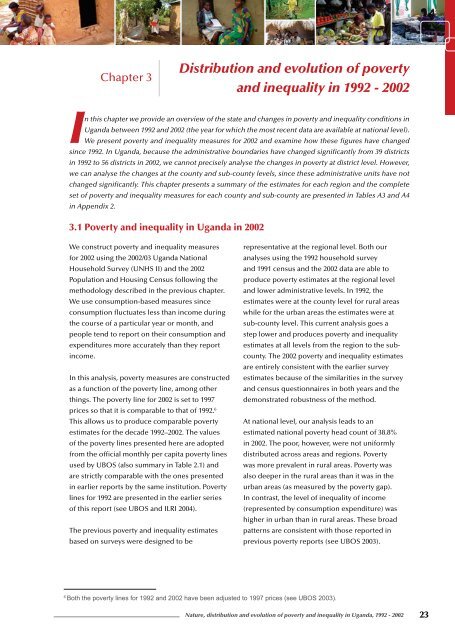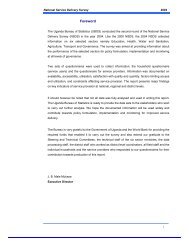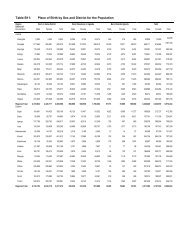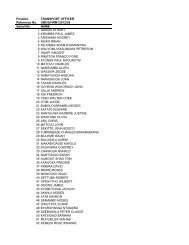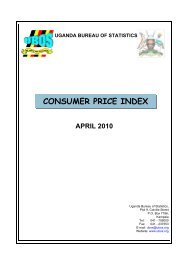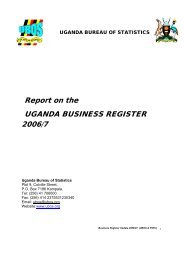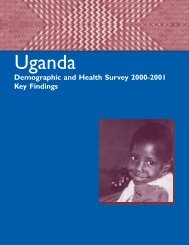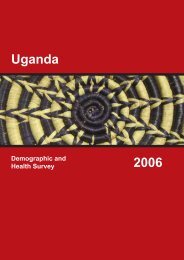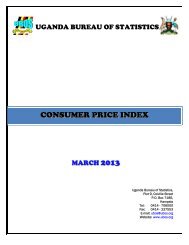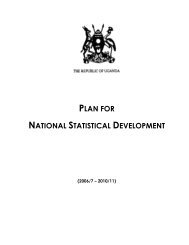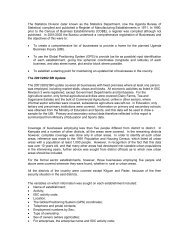Nature, Distribution and Evolution of Poverty & Inequality in Uganda
Nature, Distribution and Evolution of Poverty & Inequality in Uganda
Nature, Distribution and Evolution of Poverty & Inequality in Uganda
- No tags were found...
You also want an ePaper? Increase the reach of your titles
YUMPU automatically turns print PDFs into web optimized ePapers that Google loves.
Chapter 3<strong>Distribution</strong> <strong>and</strong> evolution <strong>of</strong> poverty<strong>and</strong> <strong>in</strong>equality <strong>in</strong> 1992 - 2002In this chapter we provide an overview <strong>of</strong> the state <strong>and</strong> changes <strong>in</strong> poverty <strong>and</strong> <strong>in</strong>equality conditions <strong>in</strong>Ug<strong>and</strong>a between 1992 <strong>and</strong> 2002 (the year for which the most recent data are available at national level).We present poverty <strong>and</strong> <strong>in</strong>equality measures for 2002 <strong>and</strong> exam<strong>in</strong>e how these figures have changeds<strong>in</strong>ce 1992. In Ug<strong>and</strong>a, because the adm<strong>in</strong>istrative boundaries have changed significantly from 39 districts<strong>in</strong> 1992 to 56 districts <strong>in</strong> 2002, we cannot precisely analyse the changes <strong>in</strong> poverty at district level. However,we can analyse the changes at the county <strong>and</strong> sub-county levels, s<strong>in</strong>ce these adm<strong>in</strong>istrative units have notchanged significantly. This chapter presents a summary <strong>of</strong> the estimates for each region <strong>and</strong> the completeset <strong>of</strong> poverty <strong>and</strong> <strong>in</strong>equality measures for each county <strong>and</strong> sub-county are presented <strong>in</strong> Tables A3 <strong>and</strong> A4<strong>in</strong> Appendix 2.3.1 <strong>Poverty</strong> <strong>and</strong> <strong>in</strong>equality <strong>in</strong> Ug<strong>and</strong>a <strong>in</strong> 2002We construct poverty <strong>and</strong> <strong>in</strong>equality measuresfor 2002 us<strong>in</strong>g the 2002/03 Ug<strong>and</strong>a NationalHousehold Survey (UNHS II) <strong>and</strong> the 2002Population <strong>and</strong> Hous<strong>in</strong>g Census follow<strong>in</strong>g themethodology described <strong>in</strong> the previous chapter.We use consumption-based measures s<strong>in</strong>ceconsumption fluctuates less than <strong>in</strong>come dur<strong>in</strong>gthe course <strong>of</strong> a particular year or month, <strong>and</strong>people tend to report on their consumption <strong>and</strong>expenditures more accurately than they report<strong>in</strong>come.In this analysis, poverty measures are constructedas a function <strong>of</strong> the poverty l<strong>in</strong>e, among otherth<strong>in</strong>gs. The poverty l<strong>in</strong>e for 2002 is set to 1997prices so that it is comparable to that <strong>of</strong> 1992. 6This allows us to produce comparable povertyestimates for the decade 1992–2002. The values<strong>of</strong> the poverty l<strong>in</strong>es presented here are adoptedfrom the <strong>of</strong>ficial monthly per capita poverty l<strong>in</strong>esused by UBOS (also summary <strong>in</strong> Table 2.1) <strong>and</strong>are strictly comparable with the ones presented<strong>in</strong> earlier reports by the same <strong>in</strong>stitution. <strong>Poverty</strong>l<strong>in</strong>es for 1992 are presented <strong>in</strong> the earlier series<strong>of</strong> this report (see UBOS <strong>and</strong> ILRI 2004).The previous poverty <strong>and</strong> <strong>in</strong>equality estimatesbased on surveys were designed to berepresentative at the regional level. Both ouranalyses us<strong>in</strong>g the 1992 household survey<strong>and</strong> 1991 census <strong>and</strong> the 2002 data are able toproduce poverty estimates at the regional level<strong>and</strong> lower adm<strong>in</strong>istrative levels. In 1992, theestimates were at the county level for rural areaswhile for the urban areas the estimates were atsub-county level. This current analysis goes astep lower <strong>and</strong> produces poverty <strong>and</strong> <strong>in</strong>equalityestimates at all levels from the region to the subcounty.The 2002 poverty <strong>and</strong> <strong>in</strong>equality estimatesare entirely consistent with the earlier surveyestimates because <strong>of</strong> the similarities <strong>in</strong> the survey<strong>and</strong> census questionnaires <strong>in</strong> both years <strong>and</strong> thedemonstrated robustness <strong>of</strong> the method.At national level, our analysis leads to anestimated national poverty head count <strong>of</strong> 38.8%<strong>in</strong> 2002. The poor, however, were not uniformlydistributed across areas <strong>and</strong> regions. <strong>Poverty</strong>was more prevalent <strong>in</strong> rural areas. <strong>Poverty</strong> wasalso deeper <strong>in</strong> the rural areas than it was <strong>in</strong> theurban areas (as measured by the poverty gap).In contrast, the level <strong>of</strong> <strong>in</strong>equality <strong>of</strong> <strong>in</strong>come(represented by consumption expenditure) washigher <strong>in</strong> urban than <strong>in</strong> rural areas. These broadpatterns are consistent with those reported <strong>in</strong>previous poverty reports (see UBOS 2003).6Both the poverty l<strong>in</strong>es for 1992 <strong>and</strong> 2002 have been adjusted to 1997 prices (see UBOS 2003).<strong>Nature</strong>, distribution <strong>and</strong> evolution <strong>of</strong> poverty <strong>and</strong> <strong>in</strong>equality <strong>in</strong> Ug<strong>and</strong>a, 1992 - 2002 23


